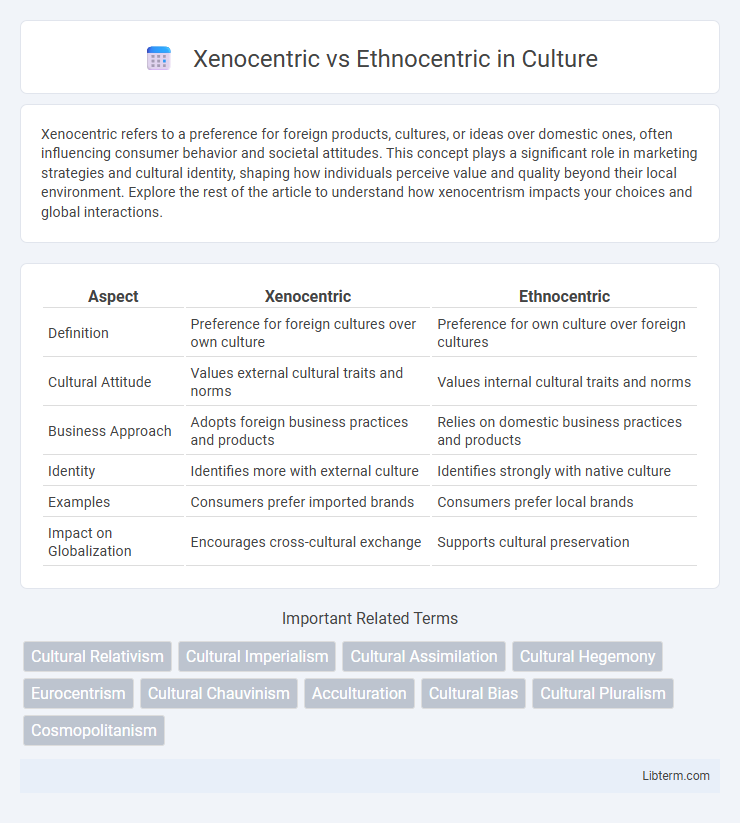Xenocentric refers to a preference for foreign products, cultures, or ideas over domestic ones, often influencing consumer behavior and societal attitudes. This concept plays a significant role in marketing strategies and cultural identity, shaping how individuals perceive value and quality beyond their local environment. Explore the rest of the article to understand how xenocentrism impacts your choices and global interactions.
Table of Comparison
| Aspect | Xenocentric | Ethnocentric |
|---|---|---|
| Definition | Preference for foreign cultures over own culture | Preference for own culture over foreign cultures |
| Cultural Attitude | Values external cultural traits and norms | Values internal cultural traits and norms |
| Business Approach | Adopts foreign business practices and products | Relies on domestic business practices and products |
| Identity | Identifies more with external culture | Identifies strongly with native culture |
| Examples | Consumers prefer imported brands | Consumers prefer local brands |
| Impact on Globalization | Encourages cross-cultural exchange | Supports cultural preservation |
Understanding Xenocentrism and Ethnocentrism
Xenocentrism describes the preference for foreign cultures, products, or ideas over one's own, often valuing external influences as superior. Ethnocentrism, in contrast, involves evaluating other cultures based on the standards and customs of one's own culture, typically resulting in a belief in cultural superiority. Understanding both concepts is crucial in cross-cultural communication and international marketing strategies, as they influence consumer behavior and cultural perceptions.
Defining the Core Concepts
Xenocentric orientation refers to a preference for foreign products, cultures, or ideas, often perceiving them as superior to domestic alternatives. Ethnocentric orientation emphasizes a strong preference for one's own country's products and cultural values, believing them to be inherently superior. These concepts influence consumer behavior, marketing strategies, and global business practices by shaping perceptions of value and quality.
Historical Context and Development
The ethnocentric approach, rooted in early colonial and imperial histories, prioritized the home country's cultural norms and practices when managing international operations, reflecting a belief in inherent superiority. In contrast, the xenocentric perspective emerged during the globalization wave of the late 20th century, emphasizing adaptation to host countries' cultures and encouraging local responsiveness. This shift was influenced by increased cross-cultural interactions and the recognition that understanding foreign markets required embracing diverse cultural frameworks rather than imposing a single national viewpoint.
Key Differences Between Xenocentrism and Ethnocentrism
Xenocentrism favors foreign cultures over one's own, often idealizing external customs, products, or values, whereas ethnocentrism centers on the belief that one's own culture is superior to others. Xenocentrism leads to a preference for foreign goods and ideas, influencing consumer behavior and cultural attitudes, while ethnocentrism can result in cultural bias, prejudice, and resistance to outside influences. The key difference lies in xenocentrism's external admiration contrasting with ethnocentrism's internal pride and superiority.
Impacts on Cultural Identity
Xenocentric orientation prioritizes foreign cultures and products, often leading to diminished cultural identity as local traditions and values may be overlooked or undervalued. Ethnocentric orientation strengthens cultural identity by emphasizing and preserving native customs, languages, and products, fostering a sense of pride and belonging. The impact on cultural identity depends on the balance between appreciating global influences and maintaining local heritage, with xenocentrism risking cultural erosion and ethnocentrism promoting cultural preservation.
Influence on Social Behavior and Attitudes
Xenocentric attitudes, characterized by a preference for foreign cultures and products, often lead to openness, curiosity, and acceptance of diversity in social behavior. Ethnocentric perspectives promote loyalty to one's own culture, resulting in in-group favoritism and potential prejudice against outsiders. These contrasting orientations significantly influence social interactions, shaping inclusive or exclusionary community dynamics.
Examples in Everyday Life
Consumers displaying ethnocentric behavior prefer domestic products, such as buying American-made cars or locally grown food to support national economies. In contrast, xenocentric individuals favor foreign goods, often choosing brands like Japanese electronics or Italian fashion for perceived quality and prestige. These preferences influence purchasing decisions, marketing strategies, and cultural identity in everyday shopping experiences.
Advantages and Disadvantages of Each Perspective
Xenocentric orientation offers advantages such as fostering global market understanding and enhancing cross-cultural collaboration, but it may lead to undervaluing local preferences and increased operational complexity. Ethnocentric orientation benefits from centralized control and consistent brand identity, simplifying decision-making while risking cultural insensitivity and limited adaptability in foreign markets. Balancing these perspectives requires assessing the trade-offs between global integration and local responsiveness to optimize international business strategies.
Navigating Between Xenocentric and Ethnocentric Views
Navigating between xenocentric and ethnocentric views requires balancing appreciation for foreign cultures with pride in one's own cultural identity. Embracing cultural diversity enhances global collaboration while maintaining ethnocentric perspectives ensures preservation of cultural heritage. Organizations and individuals benefit from developing cultural intelligence to fluidly switch between these viewpoints based on context and objectives.
Fostering Cultural Sensitivity and Global Awareness
Xenocentric perspectives prioritize valuing foreign cultures and products, enhancing cultural sensitivity and fostering global awareness by encouraging individuals to appreciate diverse traditions and practices. Ethnocentric views emphasize one's own culture as central, which can limit understanding and inhibit the development of intercultural competence. Embracing xenocentrism in global business and social contexts leads to more effective communication, collaboration, and respect across multicultural environments.
Xenocentric Infographic

 libterm.com
libterm.com